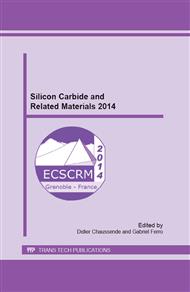p.285
p.289
p.293
p.297
p.303
p.307
p.311
p.315
p.319
Basal Plane Dislocation Analysis of 4H-SiC Using Multi Directional STEM Observation
Abstract:
A peculiar surface defect on a silicon carbide (SiC) epitaxial wafer, found to be associated a basal plane dislocation (BPD), was studied using a low energy scanning electron microscope (LESEM), and a novel method we are calling multi directional scanning transmission electron microscopy (MD-STEM). We have confirmed that an etch pit with double cores neighboring a peculiar surface defect is derived from the extended BPD. The BPD consisted of two partial dislocations with a stacking fault width of about 100 nm. Observation of only one viewing direction in a previous study missed the extended dislocation but through the use of the MD-STEM method in the current study, the dislocation has been confirmed to be extended into a stacking fault.
Info:
Periodical:
Pages:
303-306
Citation:
Online since:
June 2015
Price:
Сopyright:
© 2015 Trans Tech Publications Ltd. All Rights Reserved
Share:
Citation:


